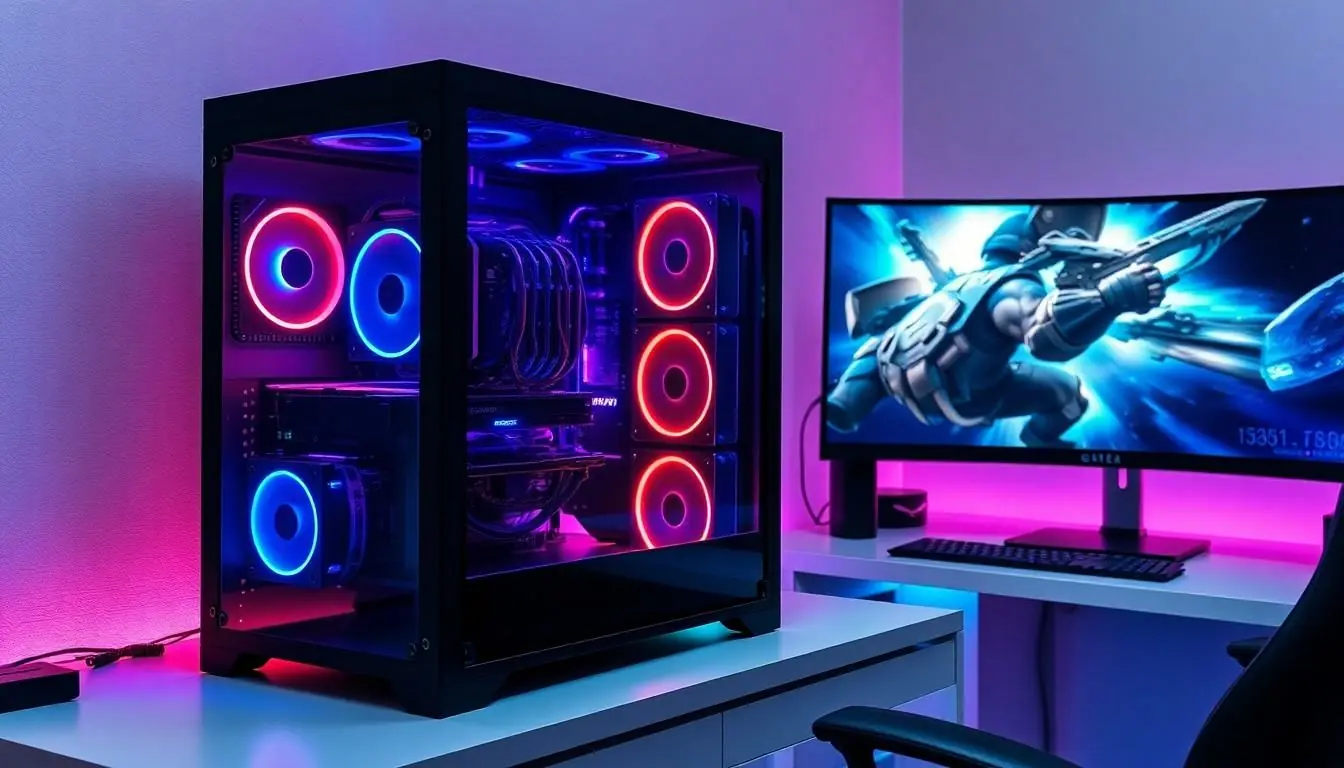Gaming PCs are like the high-maintenance divas of the tech world. They demand attention, flashy components, and yes, a hefty dose of power. But just how much energy do these beasts consume while they’re busy rendering stunning graphics and blasting through the latest AAA titles?
Table of Contents
ToggleOverview of Gaming PC Power Consumption
Gaming PCs consume significant power due to their high-performance components. The total consumption can vary widely based on the components and usage scenarios. Typically, a gaming PC uses between 300 and 800 watts during operation.
Graphics cards play a crucial role in overall power usage. High-end models often draw between 250 and 400 watts when in use. Processors also contribute significantly, with typical consumption ranging from 65 to 160 watts, depending on the generation and specifications.
Power supplies in gaming PCs come in various ratings. A standard power supply rating for mid-range systems is around 600 watts, while high-performance systems require ratings of 850 watts or more. Idle power consumption can be relatively low, often around 50 to 200 watts, but it spikes during intensive tasks.
Monitoring power consumption using software tools can aid users in understanding their specific usage. Programs like HWiNFO and HWMonitor provide real-time data on power draw, temperatures, and other important metrics. These insights can guide optimization efforts for energy efficiency.
Overall, gamers should consider both the components and the intended use when evaluating power consumption. Significant energy use translates to higher electricity costs over time, making efficiency an important factor for budget-conscious gamers. Understanding these dynamics helps create a more informed gaming setup.
Factors Affecting Power Usage
Power usage in gaming PCs depends on several factors. Understanding these elements can help users manage energy consumption effectively.
Components Impact on Power
High-performance components significantly affect power consumption. Graphics cards require substantial energy, often between 250 to 400 watts. In addition, modern processors typically consume 65 to 160 watts during operation. Motherboards, RAM, and storage devices contribute to total system power draw as well, albeit in smaller amounts. A well-balanced system with lower-tier components will use less power than one equipped with high-end hardware. Consequently, gamers focused on specific components can adjust their builds based on desired performance and energy efficiency.
Usage Patterns and Power Draw
Usage patterns play a crucial role in power consumption as well. Gamers running demanding applications notice spikes in energy draw during intense tasks, while idle periods reflect lower usage. It’s common for systems to draw significantly less power during simple activities like web browsing or streaming. Understanding these patterns enables users to schedule gaming sessions for peak efficiency. Monitoring software tools help track real-time power usage, guiding optimizations for energy savings. Adjusting settings during idle times can further reduce overall consumption, contributing to lower energy costs.
Measuring Power Consumption
Measuring a gaming PC’s power consumption involves using specific tools and understanding power supply ratings. Accurate assessments ensure users manage energy efficiently.
Tools and Equipment
Smart plugs serve as effective tools for measuring energy usage. Users plug their gaming PCs into these devices, which display real-time power draw. Power meters can also monitor energy consumption at the outlet level. Software tools like HWiNFO and HWMonitor track real-time component usage, providing insights into power consumption during various tasks. By utilizing these tools, gamers can identify power spikes and optimize their setups for better energy efficiency.
Understanding Power Supply Ratings
Power supply ratings determine how much energy a gaming PC needs to operate effectively. Ratings typically range from 300 to 850 watts based on the hardware configuration. High-end systems often require more than 850 watts to ensure stable performance under load. Balanced systems, however, may only need around 600 watts. Awareness of these ratings helps users select the right power supply, ensuring reliability during taxing tasks. Understanding these numbers allows gamers to prevent potential system failures while managing energy costs.
Typical Power Usage of Gaming PCs
Gaming PCs typically demand substantial power, influenced by their components and usage patterns.
Low-End vs High-End Systems
Low-end gaming systems often consume around 300 to 400 watts during operation. In contrast, high-end systems can peak at 800 watts or more, especially during intensive tasks. Component choice plays a significant role; for instance, entry-level graphics cards consume about 100 to 150 watts, while premium models may draw 250 to 400 watts. Processors also vary, with budget chips consuming 65 to 95 watts, whereas high-performance CPUs can reach 160 watts. Thus, the power supply follows suit, with mid-range systems typically requiring 600 watts for optimal performance, whereas enthusiasts lean towards 850 watts or greater to accommodate their robust components.
Power Usage During Different Activities
Power consumption varies based on activity. Gaming sessions, especially those involving graphically intensive titles, draw considerably more power compared to standard desktop tasks. While playing demanding games, systems can consume up to 800 watts. In contrast, light activities such as browsing or streaming often limit power draw to around 100 to 200 watts. Idle states reflect even lower usage, generally around 50 to 100 watts. Spikes during gaming sessions indicate a need for efficient monitoring, as adjusting settings can enhance energy savings. By being mindful of these consumption patterns, gamers can manage their energy costs without sacrificing performance.
Conclusion
Understanding the power consumption of gaming PCs is essential for gamers looking to balance performance and energy efficiency. By being aware of the wattage requirements of various components and monitoring usage patterns, gamers can make informed decisions that help manage energy costs.
Utilizing tools like smart plugs and monitoring software allows for real-time insights into power draw, enabling users to optimize their gaming setups effectively. With the right approach, it’s possible to enjoy an immersive gaming experience while keeping energy consumption in check, ensuring that both performance and budget remain on track.



